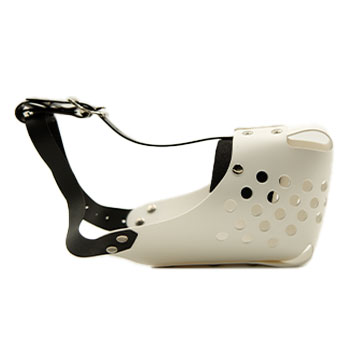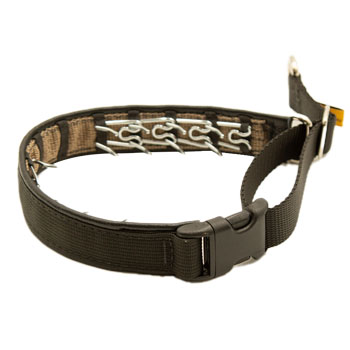April 28, 2011
My 6-month-old Kuvasz is displaying fear aggression. The problem seems to occur only when she is out of her own territory. How should I handle this dog?
Full Question:
Hello Mr. Frawley,I read through your questions and answers on fear aggression but still had some questions; I hope you do not mind that I am e-mailing you. You are doubtless busy, but I would appreciate a reply if you have the time.
My family purchased a Kuvasz puppy, our first, about four months ago, and she is now six months old. This female, named Sapphire, seems to be very territorial inside the house and in our backyard, which is somewhat normal for the breed, except that their protective instinct does normally appear until between six and nine months and matures around eighteen months; she became protective between four and five months. Unlike GSDs and similar breeds, this instinct is a breed trait that requires no training. In her case, she barks at those who enter the house and is threatening, but she does not mind delivery men at the front door, such as from UPS. She will do a sit-stay at the door and remain quiet while we take the package. However, she does bark whenever the doorbell rings. When someone enters the house, her body language is not fearful; she seems confident: she holds her tail straight up, puts her ears (that are folded, not erect) forward, and barks loudly. At first she did not bark deeply, more like a seal because she was so young, but it has become gradually deeper.
However, she is nervous outside the house and yard, her territory. Things as simple as children riding bikes and garbage cans make her very nervous, and she will attempt to run away. Her body language and actions strongly indicate fear: ears back flat against her head, tail down and frequently tucked, bolting, nervously looking around, attempting to turn back toward home, and coming to me, for protection I am guessing. I would let people approach her so that she could sniff them and get used to the idea of other people being around, but I am no longer doing this because she once snapped at a child that tried to pet her. I realize, reading your articles, that she should have received an extremely severe correction, but I failed to give it. Fortunately, she has never before nor since shown aggressiveness to a child, and has always been good with our family (there are six of us). She has only shown aggressiveness after being boarded (see next paragraph), and she was less afraid also.
We first realized that she has issues with fear aggression about one month ago, when my family took a weekend trip, and we boarded her at the vet's. This was clearly a mistake, in retrospect. When we picked her up, we were told that she had been aggressive, but nothing further. However, when I later inquired about it, the lady who had cared for the dogs over the weekend told me that she was "skittish," to the point that it would make someone "nervous." I am guessing that she had growled and snapped, judging by her later behavior. This information sent off alarm bells; it was the last thing I would have expected. Like most livestock guardian dogs (LGDs) she is somewhat food aggressive toward other dogs, so I had expected that. Fear aggression truly alarmed me; it is not typical in her breed.
I looked for advice and was told that she needed more socialization with other people than she had been given. Therefore, I have been walking her twice daily through the neighborhood, forcing her to walk past people, bicycles, garbage cans, dogs, and anything else that seems to scare her, as well as taking her out when possible; I encourage her to sniff things but not other dogs. Additionally, we learned that, although her sire has an excellent temperament, her dam was very nervous for some time and required intense socialization to overcome. Supposedly, she is fine now, but I fear it may be a genetic tendency. I am thinking that the stay at the boarding kennel may have brought out these tendencies, since there were some warning signs that I failed to recognize before that: she drew back from people and looked somewhat nervous when we were out; but there was no aggression.
Regarding normal temperament: Kuvaszok (plural for Kuvasz) are normally very aggressive in protecting their charges (their pack, I suppose), whether they are their family, chickens, goats, sheep, etc. Otherwise, they are reserved and watchful with strangers, and they will not tolerate petting except from their own family; they are not supposed to be fearful. Some dogs, like her sire, are unusual in this regard, and will actually be friendly toward people outside their territory. These dogs are also normally gentle with the people or animals that they consider as belonging to the pack, which is the case with Sapphire. They are also very independent, but intelligent, and are therefore difficult to train, but this is important in working dogs and therefore is a trait of all LDGs (Pyrs, Anatolians, Caucasians, Maremmas, Kuvaszok, Komondorok, etc.). Sapphire is typical in that regard also. The only unusual thing in her temperament, besides the things already noted, is that she seems to have a high prey drive, which is extremely unusual; they are bred to have a very low prey drive. She chases things, even when she is somewhat hot and tired, and she could easily be taught to fetch things. I am not sure if her prey drive is related to her fear aggression in any way, so I have mentioned it.
Another thing that may be relevant is that we own one other dog, an American Eskimo female that is three and has hip dysplasia. Gucci (that is this dog's name) barks at strangers that pass in the street or come to the door, often setting Sapphire off also. Gucci, however, accepts people quickly and only shows mild aggression (growly noises and sometimes snapping) when very little children (under three) approach her. It is never with strangers, except for the fierce barking, and she does not go out much. Regarding the baby, we simply watch her and keep her away from Gucci. That dog is really very tolerant, considering her severe dysplasia, and will stop making noises if we scold her. I hope this is enough information for you to get a good picture of our puppy.
How would you recommend handling Sapphire? We are moving to a very large property this year, where there will be fewer people around, and we do own crates for both dogs. Also, the reason we had bought her was as a companion and protector for the family, especially the little children. Perhaps it is unreasonable to expect her to behave well in public. However, do you think she will be manageable in public if we work with her, perhaps with a muzzle? She will be 90-100 lbs., a large dog, at maturity. Also, do you think Sapphire will be safe with the other children in our family? I noticed that you recommended that some fearful dogs be kept away from children, but she is only insecure outside of her territory, so I wondered what your opinion was. Is she old enough to use a prong collar (it is becoming hard to control her at 60+ lbs. when she attempts to bolt)? If so, which width and heaviness of collar would you recommend?
I found your site very interesting and helpful in many respects. You seem to be a very good trainer, and, although I realize that you likely have little experience with livestock guardians, I am certain that your advice would still be helpful, if blunt. I'm sure I have made plenty of stupid mistakes with a first dog like this, so you will have plenty of reason to be; however that is why I e-mailed you. Thank you very much, sir!
Sincerely,
Sofia
P.S. As you can probably tell, Sapphire is not trained. Although I have started some basic work with her, such as sit, down, stay, wait, leave it, come, she is not solid with distractions.

 Ed's Answer:
Ed's Answer:
I give you credit for trying so hard.
I would start by recommending you read an article I recently wrote which explains my philosophy of dog training. I think you will get some ideas from this.
With this said you are placing too much emphasis on the dog's breed and not enough on the actual temperament. You can’t worry about the breed – it has you thinking wrong. Heck if I thought like that, every German Shepherd would be a personal protection dog (when in fact maybe 2% of all that are bred can be – 90% of the ones I breed can be.)
This dog has the making of a fear biter. Aggression is not always seated in one area – there can be a number of causes for a dog's aggression but in your case the primary form is fear based.
I would strongly recommend that you first read the article I wrote on preventing dog bites in children. Your child is at risk here and you don’t recognize it.
You need to start to use dog crate and you need to train this dog. Training is not going to fix the fear – its going to establish control.
Get my Basic Dog Obedience DVD – its 4 hours. Get a prong collar and learn to use it.
I can tell you that if this were my dog it would be wearing a e-collar.. It would never leave the house without it on. Not ever. It would be trained with low level stimulation. I released a DVD showing people how to do this (318-D). There is no pain involved when this is used correctly.
Our dogs NEVER come in contact with other strange dogs – not ever and not for any reason. You can do what you wish but it’s a bad idea to allow a dog like this to have contact with strange dogs. For one thing you can't control it, but for another its too big to handle when a fight breaks out.
Your dog is not dominant but you need to read the article I wrote titled Dealing with a Dominant Dog – you will learn something. You should also read the article on Ground Work to Becoming a Pack Leader.
I have a saying that I tell people – it goes like this” Everyone has an opinion on how to train a dog – just ask you barber, your mailman and your neighbor” The problem is very few people have the experience to back up their opinions. This results in a lot of bad information being passed out So people like yourself need to figure out who has the experience to warrant listening to. Don’t fall into this trap.
I would start by recommending you read an article I recently wrote which explains my philosophy of dog training. I think you will get some ideas from this.
With this said you are placing too much emphasis on the dog's breed and not enough on the actual temperament. You can’t worry about the breed – it has you thinking wrong. Heck if I thought like that, every German Shepherd would be a personal protection dog (when in fact maybe 2% of all that are bred can be – 90% of the ones I breed can be.)
This dog has the making of a fear biter. Aggression is not always seated in one area – there can be a number of causes for a dog's aggression but in your case the primary form is fear based.
I would strongly recommend that you first read the article I wrote on preventing dog bites in children. Your child is at risk here and you don’t recognize it.
You need to start to use dog crate and you need to train this dog. Training is not going to fix the fear – its going to establish control.
Get my Basic Dog Obedience DVD – its 4 hours. Get a prong collar and learn to use it.
I can tell you that if this were my dog it would be wearing a e-collar.. It would never leave the house without it on. Not ever. It would be trained with low level stimulation. I released a DVD showing people how to do this (318-D). There is no pain involved when this is used correctly.
Our dogs NEVER come in contact with other strange dogs – not ever and not for any reason. You can do what you wish but it’s a bad idea to allow a dog like this to have contact with strange dogs. For one thing you can't control it, but for another its too big to handle when a fight breaks out.
Your dog is not dominant but you need to read the article I wrote titled Dealing with a Dominant Dog – you will learn something. You should also read the article on Ground Work to Becoming a Pack Leader.
I have a saying that I tell people – it goes like this” Everyone has an opinion on how to train a dog – just ask you barber, your mailman and your neighbor” The problem is very few people have the experience to back up their opinions. This results in a lot of bad information being passed out So people like yourself need to figure out who has the experience to warrant listening to. Don’t fall into this trap.
70% (16 out of 23)
respondents found this answer helpful


Can't find what you're looking for?








.jpg)